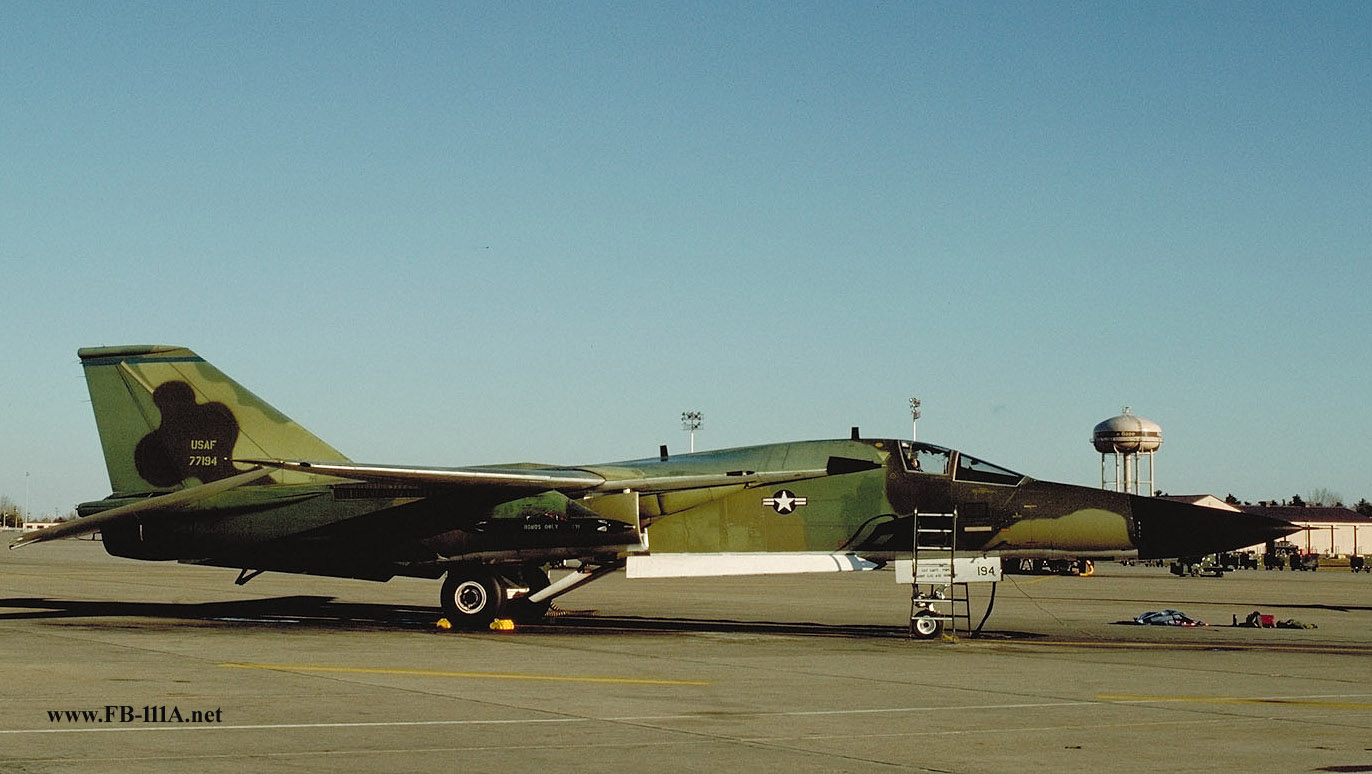
Mishap: an accident or unlucky event. Covered on this page are major mishaps that took place during the 20 years of flying the FB-111A. Ten crewmembers perished when their aicraft crashed and ejection failed. The informations provided on this page come from USAF Accident/Incident Report in the FB-111.net archives and additional infos found in the book "One-Eleven Down" by S. Hyre and L. Benoit.

Mishap #1. On 29 November 1971, this particular aircraft assigned to 509th BMW departed on a routine training mission at 18:37 EST. Due to deteriorating weather conditions, the crew was directed to return to base after 3 hours of flight. Upon arrival, an instrument penetration to a ground controlled approach was accomplished. Extensive dammage to the aircraft occured when the aircraft departed the edge of Runway 34 during a night landing.
The crew was composed of Maj Edwin M. Moorman (P) and Maj James M. Brighenti (N) from the 393rd Bombardment Squadron, 509th BMW.
Mishap #2. On 25 February 1976, the mishap aircraft (67-7194) departed for a mission including formation training with wingman enroute to AR206 (refueling track), where cell refueling was accomplished. The mishap aircraft then entered low level route OB-11. After this training was accomplished, the crew rejoined with their wingman and proceeded back to Pease AFB. Mishap aircraft received enroute and descent, followed by radar vectors from Pease RAPCON to PAR final approach. Shortly after passing one mile from touchdown, final control advised aircrew twice that they were well below glide path, followed by the transmission "If runway or approach lights not in sight, climb and maintain one thousand three hundred heading three four zero". The mishap pilot replied " I'm visual." This was the last transmission from the mishap aircraft. Due to low visibilty and absence of radio contact with the mishap aircraft, RAPCON informed the supervisor of flight (SOF) to make a runway check. The SOF started north on runway 34 and discovered a right main landing gear laying on the right side of the runway, approximately 600 feet from the approach end. After proceeding down the runway, the SOF located the mishap aircraft 4600 feet from the runway threshold just left of the center-line. A fire was present in the main wheel well which was extinguished by base fire personnel. The crew had safely egressed the mishap aircraft when the SOF found them.
The crew was composed ofCapt James N. Gabriel (P) and Capt Michael H. Labeau (N) from the 715th Bombardment Squadron, 509th BMW.
Following this second mishap, the aircraft was repaired and back to flying status with the 380th BMW in September 1980. The aft fuselage of aircraft 67-0160 was mated to the forward fuselage of 67-7194, along with a spare vertical stabilizer from 69-6513. Because GDFW used a conglomeration of parts to rebuild 67-7194, the aircraft was nicknamed 'Frankenvark'. It is interesting to note that 7194 is the only FB to have crashed twice on the same end of the same runway.
This was the first aircraft to go through the General Dynamics battle damage line in Ft. Worth. This program, over the years, returned several badly damaged F/FB-111 aircraft to service.
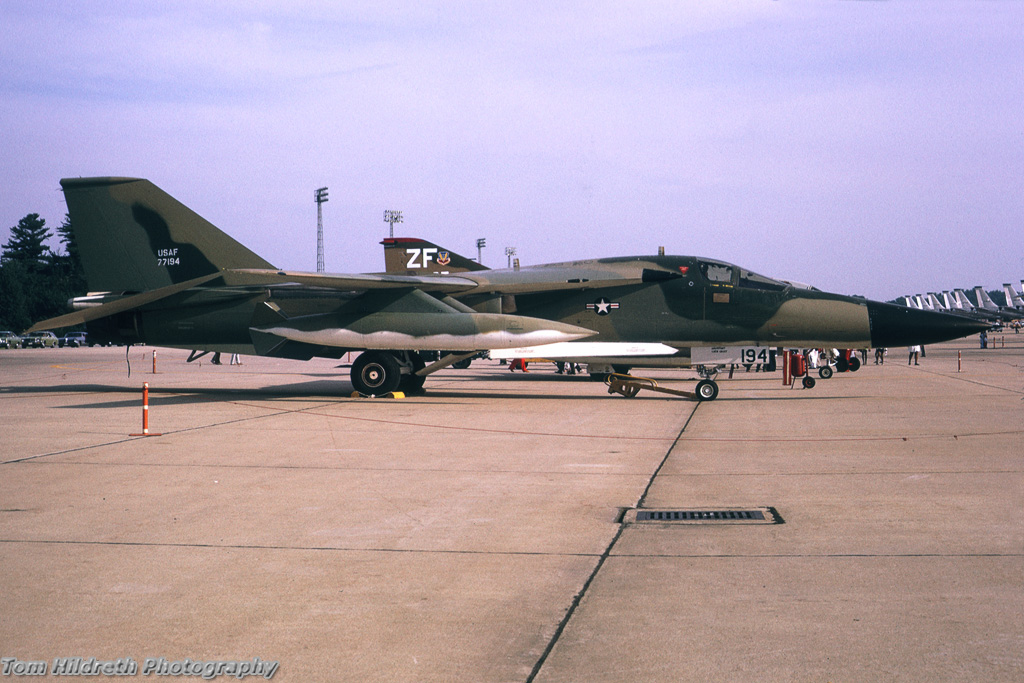
On 7 June 1983, a three ship formation of FB-111A aircraft launched on a routine Red Flag training mission from Nellis AFB, Nevada. 'Maul 42' (the mishap aircraft) was the second aircraft in the formation. Prior to entering IR 126, the three aircraft increased spacing between aircraft to approximately 5 miles, twenty seven minutes after low level entry, Maul 42's left engine number one fan hub failed from fatigue, releasing a first stage fan blade. An inflight fire confirmed by the number three aircraft (Maul 43) resulted. The aircrew sucessfully ejected and the aircraft crashed in an isolated desert area in Arizona.
The crew was composed of Maj Richard B. Young (P) and Capt Raymond A. Drogan (N) from the 393rd Bombardment Squadron, 509th BMW.
On 30 January 1989, the mishap aircraft was involved in a unit directed Emergency War Order generation. During that exercise, external fuel tanks were loaded on stations 2,3,6 and 7. Stations 2 and 7 were subsequently downloaded prior to the mishap flight. The mishap aircraft was scheduled to fly as part of the unit's exercise on 2 Feb. 1989 as Heat 22. Scheduled items included a MITO takeoff, air refueling in WL02, and low level activities in IR 800. On 2 Feb. 1989, at 10:50 EST, Heat 22 took off as number two in a two-ship formation flight. At 11:34 EST, Heat 22, s crew requested to return to base. At 11:40 EST, Heat 22 declared an inflight emergency with Boston Air Traffic Control Center because of an external stores problem. By 11:44 EST, Heat 22 started a descent to 10,000 feet MSL. Boston Center radar plots indicate that the last altitude of Heat 22 was 13,000 feet MSL. At 11:46 EST, Boston Center radar indicated a primary target og Heat 22. After that point, Boston Center had no verbal or radar contact with Heat 22. Aircraft wreckage from Heat 22 was located on a mountain side near Kirby, VT.
The crew was composed of Capt Randall S. Voorhees (P) and Capt Leonard J. Esterly Jr (N) from the 529th Bombardment Squadron, 380th BMW.
FB-111A 68-0253 was scheduled for a 5.0 hour aircrew training mission to include air refueling, low level bombing, followed by pilot transition at Carswell AFB. Prior to takeoff, the low level mission was cancelled due to weather, and the mission was changed to air refueling and pilot transition. Takeoff was at 18:25 CDT, 7 October 1970.
The aircraft proceeded through takeoff, climb and air refueling with no reported problems. Twelve thousands pounds of fuel was onloaded from a KC-135A in the Busy Marshall refueling area, then the aircraft returned directly to Carswell AFB, TX. At 20:05 CDT, while en route to Carswell, the Inertial Navigation System was lost. This was ascertained by a notation on the navigation inflight log. At 20:30 CDT, the aircrew advised the 7th Bombardment Wing Command Post of the loss of the Inertial Navigation System. The aircraft penetrated to Carswell AFB at 20:42 on a Tacan published penetration.
The last GCA was declared a full stop landing. After the last ILS low approach, the aircraft was vectored to 270" at 3000 feet on a crosswind leg for his final GCA, full stop landing. The downwind leg was 350" at 3000 feet, then a pattern correction turn to 020" was made followed by a heading change to 080" for a base leg. The pattern appeared normal to the GCA Controller until radar and radio contact was lost on the Carswell TACAN 340" radial at 9 nautical miles. The aircraft was totally destroyed on impact. The aircrew escape module separated from the aircraft; however the escape was unsuccessful, and the pilot and navigator received fatal injuries.
The crew was composed of Ltc Robert S. Montgomery Jr. (P) and Ltc Charles G. Robinson (N) from the 340th Bombardment Group.
The mission was scheduled as the crew's first Red Flag sortie on 18 September 1979. It consisted of a stereo route departure, visual formation, low level navigation, and simulated bombing in a heavily defended target area. After completing the low level portion of the mission, a formation rejoin was planned with recovery to Nellis AFB, Nevada. The crew made an on-time takeoff at 13:40 PDT. The mission proceeded without apparent difficulty until approximately 14:55 PDT. At that time, the mishap aircraft was observed on radar to be exiting the Military Operating Area to the North, away from the other two aircraft with whom he was scheduled to rejoin.
At approximately 15:02 PDT, the lead aircraft reported to the range control group that they had lost electronic contact with the mishap aircraft and informed range control that they were observing a plume of smoke to the North. A surveillance aicraft proceeded to the North attempting to determine the source of the smoke. The smoke and fire were attributed to the crash of the mishap aircraft. No ejection attempt initiated and the remains of both crew members were found in the wreckage.
The crash occured 120 NM of Nellis AFB, NV. The crew was composed of Capt Phillip B. Donovan (P) and Capt William J. Full (N) from the 393rd Bombardment Squadron, 509th BMW.
On 30 January 1981, the mission was added to the weekly flying schedule as a Functional Check Flight (FCF). It was scheduled as a single-ship sortie to accomplish the required FCF after a double engine change, The mishap crew was to proceed to IR 800 for low-level navigation and simulated bombing practice, then return to home station for landing. Because of pre-flight maintenance delays, the low level and bombing practice were cancelled prior to take-off. The mishap crew took off at 13:56 EST, approximately two hours late. The mission was flown as scheduled with no significant deviations or known problems, until the return to home station leg. During the enroute descent the aircraft departed controlled flight. Unable to bring the aircraft back under control, the mishap crew successfuly ejected without injury. The aicraft crashed 2 NM east of Pease AFB in the outskirts of Portsmouth, NH. The crew module landed 1,750 feet east of the crash site near Interstate Highway 95.
The crew was composed of Capt Peter Carellas (P) and Maj Ronald J. Reppe (N) from the 715th Bombardment Squadron, 509th BMW.
On 14 February 1977, the mishap aircraft "Orb-16" was the lead aircraft of a two-ship formation from take-off until low-level entry. This mission was the first for this aircraft afetr 58 days of ground alert. Scheduled activity included a visual lead formation check, air refueling, low-level navigation, Radar Bomb Scoring (RBS), Electronic Counter Measures (ECM) training, and high and low altitude simulated AGM-69A SRAM launches, then return to Pease AFB. Prior to launch the air refueling was cancelled. Pre-flight, engine start and taxi were accomplished without incident. The crew launched at 18:27 L and proceeded direct to the entry control point for the Olive Branch 14 (OB-14) or Oil Burner low-level route, accomplishing the formation maneuvering as briefed. The formation was split up, and the aircraft entered OB-14 as a single-ship at 20:34 L. The mishap aircraft was tracked performing normally until Point J on the planned route. At that point, Atlanta Air Route Traffic Control Center (ARTCC) via Data Analysis Reduction Tool (DART) indicated that Orb-16 had descended to 6,700 feet MSL. The IFR route structure at this point is 7,700 feet MSL. At Point K, Orb-16 descended to 4,700 feet MSL, where the route structure at this point directs a descent to 6,700 feet MSL. Indianapolis ARTCC voice tapes indicate the mishap aircraft made initial radio contact and reported level at 4,700 feet MSL at Point L, a 6,700 feet MSL level off point on the route. Approximately three minutes later, at 20:54 L, Orb-16 began impacting large trees atop a mountain peak along the route at approximately 4,500 feet MSL. The aircraft received extensive structural dammage on initial tree impact. The aircraft traveled about 1,400 feet after initial contact with the trees and then crashed. Debris from the ground impact and subsequent explosion covered an area of more than one mile. Both crewmembers were fatalities.
The crew was composed of Capt Edward A. Riley Jr (P) and Capt Jeremiah F. Sheehan (N) from the 715th Bombardment Squadron, 509th BMW.
On 6 October 1980, the mishap aircraft departed Plattsburgh AFB in Upstate New York, as number 2 in a two-ship formation at 21:19 EDT. After level-off, the formation lead was changed and the mishap aircraft became the lead aircraft. At the Bangor 199/41, the formation separated to allow the mishap aircraft to enter the low-level route twelve minutes ahead of his wingman. At 21:58 EDT, the mishap aircraft entered IR-800 at 17,000 feet. Shortly thereafter the mishap crew requested clearance to make a Tactical Auto TF descent. The request was approved. At the Bangor 103/57 the mishap aircrew reported initiating descent. The mishap aicraft then continued along the planned route until reaching Bangor 134/59. At 22:12 EDT, Boston Center lost radar contact with the mishap aircraft. Boston Center and the mishap aircraft's wingman conducted an unsuccessful communications search. At 22:30 EDT, Boston Center was advised by the U.S.Coast Guard station in Jonesport, ME, that a citizen had reported seeing and hearing an explosion on the water. A short time later, floating wreckage and debris were found, and it was determined to be from the mishap aicraft. Both crew members perished in the crash. The crew was composed of Maj Thomas M. Mullen (P) and Capt Gary A. Davis (N) from the 4007th CCTS, 380th BMW.
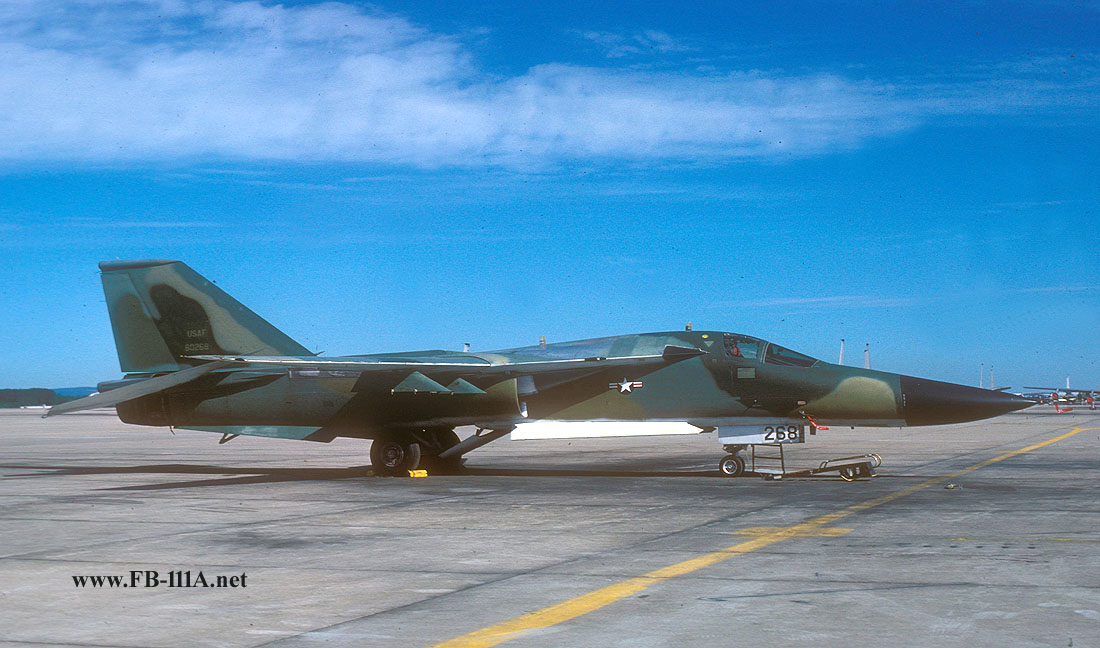
On 30 July 1980, the mission was scheduled as a single-ship sortie consisting of a standard instrument departure and cimb-out to FL220, inflight refueling, low-level navigation, simulating bombing, fighter aircraft intercept exercises and multiple approaches upon return to Pease AFB, NH. An aircraft tail number change was effected by maintenance personnel prior to the mishap's aircrew arrival. The subsitute aircraft was preflight inspected by a buddy flight crew. The mishap aircrew accepted the aircraft, completed all remaining checklist items and accomplished an on-time take-off at 09:58 EDT. Enroute to the low-level entry control point was flown as scheduled, with no significant problems noted. During the descent to the low-level corridor, the aircraft entered a maneuver which resulted in an out of control condition. The crew successfuly ejected and the aircraft crashed 54 NM north of CFB Bagotville, QC. The escape capsule landed in a small lake full of logs.
The crew was composed of Maj Walter L. Mosher (P) and Capt Jackie T. Shallington (N) from the 393rd Bombardment Squadron, 509th BMW.
On 3 February 1975, two FB-111A 68-0280 (Dowell 45) and 69-6505 (Dowell 46) collided during a night formation joinup air refueling. All crewmembers ejected safely with no injuries. Both aircraft crashed near South Londonderry, Vermont and were destroyed.
Both mishap aircraft were scheduled as a two-ship night, low-level, air refuleing training sortie. Pre-flight, taxi and take-off were accomplished without incident afetr minor maintenance delays. The flights were uneventful through bomb release over the Fort Drum, NY, Bomb Plot. Boston Center cleared Dowell 46 to FL220 and told the crew to hold at point D2 to wait for Dowell 45. Dowell 46 had completed one orbit when they heard Dowell 45 get clearance to FL230 enroute to point D2. Dowell 45 requested initial information from Linda 21, the refueling tanker, but never heard an answer. TACAN air-to-air frequencies were set to effect the FB-111 rendez-vous, but lock-on never occured. The navigators attempted radar contact, but that was also unsuccessful. Dowell 46 was cleared by Boston Center to turn toward Dowell 45 to effect the join-up and they compared Bomb Navigation Distance Time Indicator (BNDTI) readouts to estimate their relative position. Boston Center gave Dowell 46 a left turn as Dowell 45 passed abeam, whcih should have put them in ten mile trail with Dowell 45 in the lead as planned. Dowell 45 slowed to Mach 0.67 while Dowell 46 maintained Mach 0.74 to aid in the closure. After a vector from Boston Center, the pilot of Dowell 46 saw Dowell 45's anti-collision light and confirmed it by having Dowell 45 turn it off momentarily. At Point D2, Dowell 45 turn left to Point D3 and told Dowell 46 to cut him off in the turn. Dowell 46 started the cutoff but temporarily lost sight of Dowell 45. During the turn, the pilot of Dowell 45 saw 46's anti-collision light one to two miles at eight o'clock low. Dowell 46 reacquired visual contact during the turn and conitnued the cut-off by maintaining the light at his 2 o'clock position. As Dowell 45 rolled out toward point D3, the pilot of Dowell 46 believed he crossed behind to Dowell 45's 5 o'clock with about one mile separation. Dowell 45 was concerned that he had not yet confirmed the tanker's altitude, so he obtained clearance from Boston Center to descend early to the block altitude of FL180 to 210. Dowell 46 heard this clearance and told Dowell 45 he had him visual and he was also cleared to descend. Dowell 45 reduced power and began a very slow descent. At this time, Dowell 45 planned to descend only to FL210, but Dowell 46 expected the flight to descend to FL190. The pilot of Dewell 46 began a descent also and recalled checking his altimeter as he descended through FL210. During the join-up, the pilot of 46 was devoting almost all of his attention to 45's anti-collision light, the only light he saw. In the descent, Dowell 46 checked his Mach and noted that he was 0.70 to 0.71. Dowell 45 was holding at 270 KCAS and his slow descent never went below FL225. Dowell 45 crossed point D3. Dowell 46 estimated his distance to be 1/2 mile at 5 o'clock, then suddenly realized that he was very close to Dowell 45 and began a rapid right bank to avoid collision. Dowell 46 never saw any part of Dowell 45's aircraft except the anti-collision light. Dowell 46's left wing struck Dowell 45's aircraft in the rear, causing the crew of 45 to experience a sensation of being pushed. Dowell 45's aircraft immediately entered a rapid uncontrollable roll to the left. The navigator saw a large fireball ti his immediate right and reached for the ejection handle, hesitated momentarily, then ejected the capsule. The pilot of Dowell 45 had also decided to eject at this time and was reaching for the handle when ejection occured. Dowell 45 ejected at 22,480 feet MSL at Mach 0.62, approximately 35 degrees nose low inverted on a heading of 052. Dowell 46 was in a 30 to 60 degree right bank when the collision occured. After the collision, the crew of 46 was thrown hard right, indicating that the aircraft entered a hard left roll. They noted fire on the left side of the aircraft and attempted to right the aircraft by applying right rudder and right forward stick movements. After 1 to 5 seconds of control inputs, the pilot of Dowell 46 initiated ejection. Ejection was at 26,000 feet MSL, Mach 0.43, inverted 80 degrees nose high, left wing low on a 315 degree heading. Both ejection sequences were successful and both aircraft crashed near Londonderry, Vermont.
The crew of Dowell 45 (68-0280) was composed of Capt John E. Hockenberger (P) and 1Lt James D. Kotton.
The crew of Dowell 46 (69-6505) was composed of Capt Larry I. McMaster (P) and Capt Donald G. Vann from the 529th Bombardment Squadron, 380th BMW.
On 8 January 1971, the mishap aircraft was lost on a routine USAF Acceptance Functional Check (FCF). The aircraft took-off from Carswell AFB, Texas, and crahsed close to the north shore of Lake Pontchartrain, approximately 4.5 NM east of Mandeville, Louisiana. The USAF search for more than one month, sifting through all possible route deviations from the scheduled flight path to no avail. On 2 February 1971, the crash site was discovered by two local Louisiana contractors in heavily wooded marshy swamplands. Ejection sequence was initiated but was out of the envelope. The mishap aircraft was fresh from the factory and being flown on a General Dynamics pre-acceptance flight check. Because the aircraft crashed prior to delivery, no official USAF crash report exist.
The crew was composed of LtCol Bruce D. Stocks (P) and Maj Billy C. Gentry (N) from the 4111th BS/340th BG.
On 28 October 1977, the mission was scheduled as an initial qualification check with the student pilot in the left seat. The sortie consisted of an instrument departure, visual formation, air refueling, low level navigation and bombing, and a return to Plattsburgh AFB, NY, for traffic pattern activity. Preflight, engine start and taxi were accomplished without incidents. The aircraft took-off at 08:08 EDT, The mission proceeded without reported difficulty until approximately 10:30 EDT. At that time, and while on the Oilve Branch 27 low level route, the crew declared an emergency with the Boston ARTCC, stating they had an engine fire and were proceeding to Loring AFB, Maine. Shortly afterthis call, the crew stated over the Ashland, ME, Radar Bomb Scoring (RBS) site frequency that they might have to eject. Ejection was initiated at approximately 6,000 feet MSL, and the crew module successfuly separated from the aircraft. Shortly thereafter, the aircraft crashed in a nearly vertical attitude into a river and was destroyed. The crew module descended into a densely wooded area, and a portion of a six-inch diameter tree penetrated the floor of the module, bruising the left leg of the instructor pilot, who occupied the right seat. The mishap crew proceeded on foot to a nearby clearing, and at approximately12:30 EDT was rescued by helicopter. Crash location was 6 NM west-southwest of Ashland, ME.
The crew was composed of Capt John D. Miller (P) and Capt. John J. Blewitt Jr. (N) from the 4007th CCTS, 380th BMW.
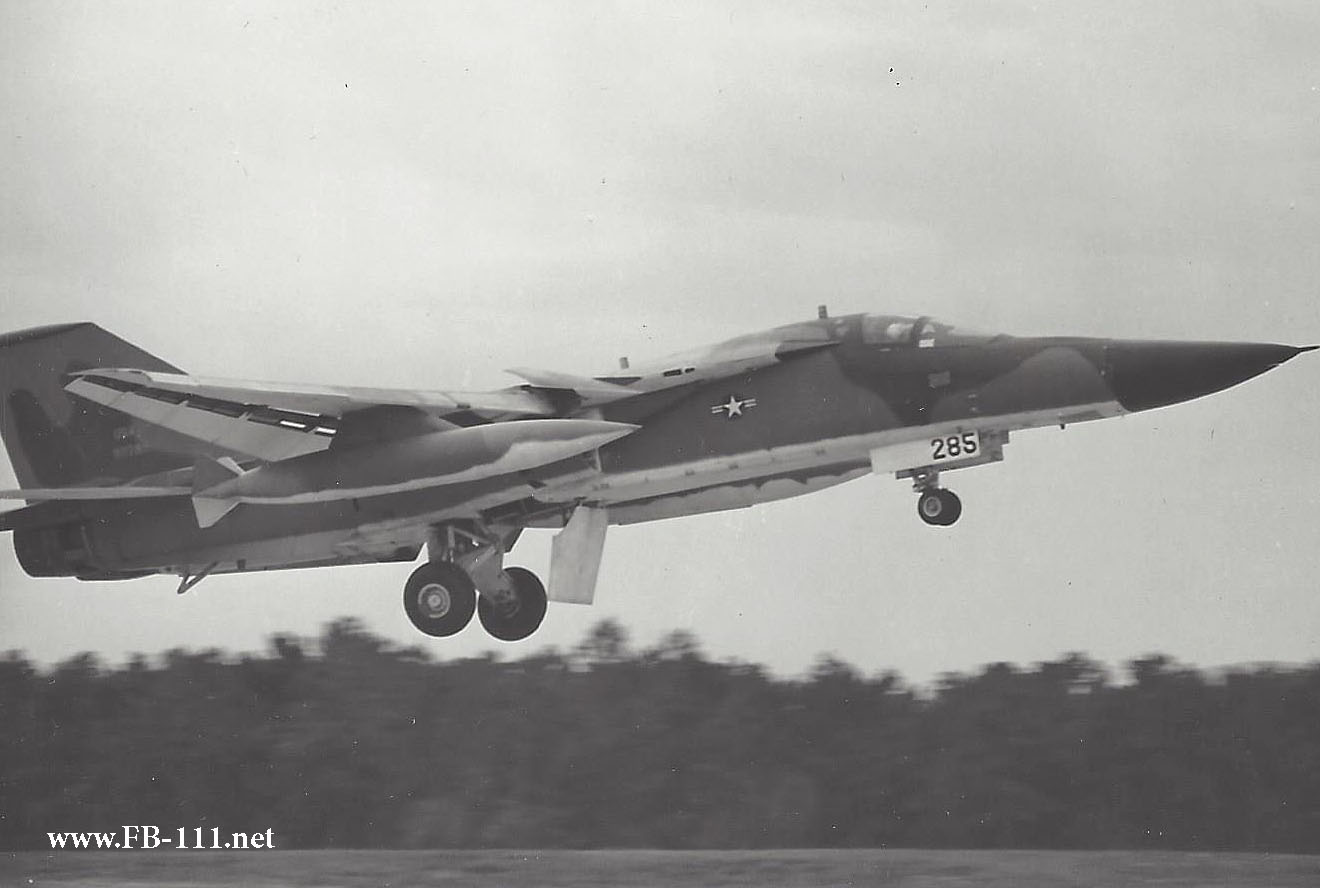
Crew R-76, Capatin Robert Pavelko and Captain Michael Sprenger, planned the proposed mission on 22 December 1975. The mission planning phase was normal with the exception of an aircraft change from 67-0161 to 68-0290. The following morning, the crew reported to Base Operations, completed their pre-mission briefings, filed their flight plans and proceeded to their aircraft. Pre-flight was accomplish and take-off was performed on time at 09:20 EST. Following Caledonia published instrument departure, the aircraft was leveled at FL220 and proceeded toward the entry fix for the Oil Burner (OB-27) low altitude route. The aircraft entered the route on time at 10:00L, and shortly thereafter started a descent to low altitude. The low altitude portion of the mission was flown normally to a point 60 to 90 seconds prior to the first scheduled simulated bomb release. At this point, the aircraft commander declared an aborted bomb run because of an apparent engine failure. The mishap pilot climbed and turned northeast towards Loring AFB, Maine. Shortly after this turn to Loring, the pilot experienced a yaw and rolling motion to the right which he was unable to control. During the out of control maneuver, the mishap pilot initiated ejection at 3,660 feet MSL. Ejection occured at 11:03EST. All portions of the ejection sequence were successful, with no injuries sustained by either crew member. The crew remained in the immediate vicinity of the crew module until they were rescued by helicopter at 12:40EST. The crash site was 5.7 miles west of Ashland, Maine.
The crew was composed of Capt Robert J. Pavelko (P) and Capt Michael R. Sprenger (N) from the 529th Bombardment Squadron, 380th BMW.
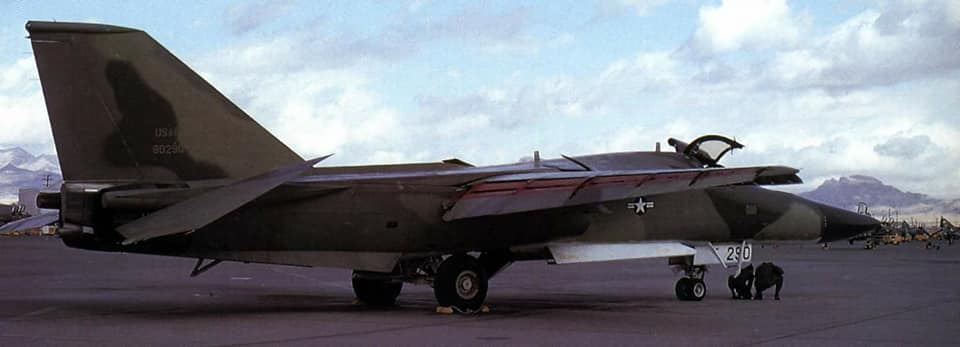
On 29 September 1972, the mishap aircraft was scheduled for low-level tarining on the Oil Burner (OB-23) route and Radar Bombing Score (RBS) training. Engine start, taxi and take-off at 23:56Z were accomplished without incident. Cimb out, cruise to the OB-23 entry point, OB-23 activity and return to local Plattsburgh area were uneventful, with the exception of minor course deviations for weather to and from OB-23. ARTCC gave clearance for a descent from cruise altitude of FL210 to 10,000 feet, and then radar hand-off was made to Burlington Approach Control. Burlington approach then cleared the mishap aircraft to 6000 feet, heading of 090 degrees, enroute to the ALTONA intersection for radar pickup for a planned precision GCA low approach to Plattsburgh AFB runway 17. Burlington approach coordinated radar transfer to the Plattsburgh radar pattern controller. During the initial contact, realizing that a dog leg was not possible due to the aircraft's position, the pattern controller issued instructions for a right turn to heading 180 degrees and a descent to 2000 feet. The mishap aircraft crossed the extended radar runway centerline at 12 NM, still apparently on the 090 degrees heading. The pattern controller directed a heading change to the right to 210 degrees, then 230 degrees. At this time, control was transferred to GCA final controller on the same frequency with the aircraft on the 230 degree heading, descending. The final controller established positive radio contact, directed a left turn to 200 degress, then attempted to make the final approach intercept by giving a left turn to 170 degrees and then 160 degrees. At this time, the mishap aircraft crossed the final approach course on the 230 degrees heading at 7 NM. The aircraft, still descending to 2000 feet, configured for landing/low approach. During or shorthly after the GCA turns to 150 and 130 degrees were given, the mishap pilot visually acquired Clinton County Airport runway lights, incorrrectly identifying the light pattern at the Plattsburgh AFB runway. The mishap pilot landed at the Clinton County Airport on a 5000 runway, ran out of hard surface and skidded off the overrun into a field.
The crew was composed of Maj Bennie L. Woytovich (P) and Capt Andrew Z. Stepniewski (N) from the 4007th CCTS, 380th BMW.
Go to "Landing at Clinton County Airport" to read more about this event.
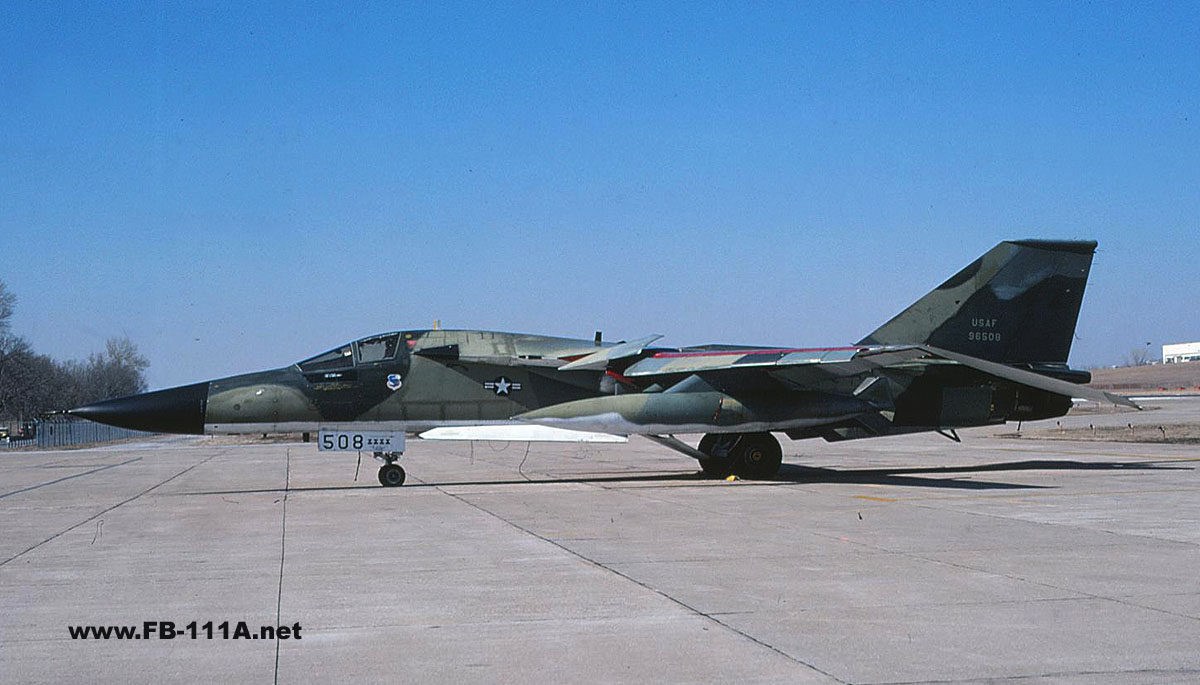
On 7 June 1976, the mishap aircraft was scheduled as number 2 in a two-ship low-level training sortie. Preflight checks, engine start, taxi and take-off were on time at 08:57 EDT. Departure join-up, enroute pre-refueling procedures and refueling were conducted without incident. Low-level entry into Oil Burner (OB-27) was accomplished, and a normal in-trail bomb run was made. After flying the alternate exit in northern Maine, the mishap aircraft leveled off at 22,000 feet and proceeded back toward Plattsburgh AFB, NY. A line of thunderstorms south and east of Plattsburgh necessitated a deviation to the south. After clearing the weather, a turn was made northbound to the Plattsburgh area. The pilot obtained destination weather requested an enroute descent from Boston ARTCC. While descending from 19,000 feet to 10,000 feet, radio and radar contact was lost. The mishap crew successfuly ejected at an altitude of 8120 feet MSL. The crew escape module came to rest on the ground in a wooded area in a steep bank to the right. The crew was picked up by helicopter from Plattsburgh AFB at 13:10EDT. The aicraft impacted the ground in a slight descent 3.3 mile NE of the capsule site in a woody marshy area. The aircraft cut a 615 foot swath through the trees, the major portion of the wreckage came to rest relatively intact and was engulfed in flames.
Thew crew was composed of Capt Raymond T. Wilson (P) and Capt Richard A Bernardi (N) from the 529th Bombardment Squadron, 380th BMW.